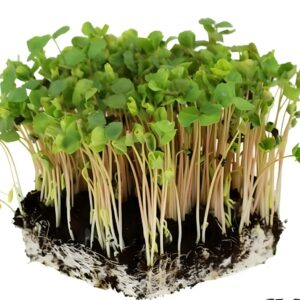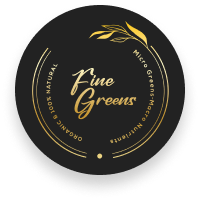| Iron (Fe) | 0.67 mg |
| Zinc (Zn) | 0.37 mg |
| Copper (Cu) | 0.09 mg |
| Manganese (Mn) | 0.37 mg |
| Cadmium (Cd) | < 0.0001mg |
| Lead (Pb) | < 0.0001mg |
| Vitamin Content | |
| Vitamin A (ᵦ-carotene) | 221.80 mg |
| Vitamin C (Ascorbic Acid) | 51.0 mg |
| Vitamin E (tocepherol) | 24.1 mg |
| Vitamin K (Phylloquinone) | 2.8 ug |
| Antioxidant bioactive compounds (Bioaccessibility %) | |
| Glucoraphanin | 4.8 µmol / g |
| Total isothiocyanates (sulforaphane) | 633.11mg, 32.30% |
| Total anthocyanins (cyanidin-3-glucose) | 12.66, 0% |
| Total soluble polyphenols | 2017.38, 70.09% |
| Other Nutrients | |
| Fiber | 410 mg |
| Broccoli Microgreens Protein | 2300 mg |
Kohlrabi
Kohlrabi
With its interesting name, textured and often brightly-colored skin, it’s a shame that kohlrabi hasn’t been noticed more. Some people refer to kohlrabi as “the forgotten vegetable.” It is a member of the cabbage family and has been cultivated in Europe and Asia for centuries.
With its interesting name, textured and often brightly-colored skin, it’s a shame that kohlrabi hasn’t been noticed more. Some people refer to kohlrabi as “the forgotten vegetable.” It is a member of the cabbage family and has been cultivated in Europe and Asia for centuries. The name kohlrabi comes from the German word “kohl” which means cabbage and “rabe” meaning turnip. It’s also known as the “poor man’s cabbage.” This may be because it looks like a turnip and tastes sort of like cabbage and broccoli, giving you multiple flavors in one veggie!
Let’s break down the taste and flavor profile of kohlrabi.
Leaves: When young, they’re great raw in salads. Older leaves can be sautéed or steamed like other greens. Leaves taste a bit like turnip greens.
Bulb: This is the main part of kohlrabi. The size of the bulb affects the taste: smaller bulbs are sweet and tender, while larger bulbs are tough and more bitter. Peel away the outer skin before using it raw in salads, or chopped and used in slaws. You can use the raw chopped bulb as a radish substitute. Raw kohlrabi is crunchy and slightly spicy!
If boiling, or steaming, you can remove the skin afterward. Cooked kohlrabi takes on more of a sweet and mild flavor.
Stalks: Kohlrabi stalks are crunchy and taste like a cross between radish and cucumber.
Kohlrabi microgreens: Purple kohlrabi microgreens are commonly grown. They are tender and mild-tasting with a slightly sweet hint of broccoli. Some describe it as having a mild cabbage flavor.
With its interesting name, textured and often brightly-colored skin, it’s a shame that kohlrabi hasn’t been noticed more. Some people refer to kohlrabi as “the forgotten vegetable.” It is a member of the cabbage family and has been cultivated in Europe and Asia for centuries. The name kohlrabi comes from the German word “kohl” which means cabbage and “rabe” meaning turnip. It’s also known as the “poor man’s cabbage.” This may be because it looks like a turnip and tastes sort of like cabbage and broccoli, giving you multiple flavors in one veggie!
Let’s break down the taste and flavor profile of kohlrabi.
Leaves: When young, they’re great raw in salads. Older leaves can be sautéed or steamed like other greens. Leaves taste a bit like turnip greens.
Bulb: This is the main part of kohlrabi. The size of the bulb affects the taste: smaller bulbs are sweet and tender, while larger bulbs are tough and more bitter. Peel away the outer skin before using it raw in salads, or chopped and used in slaws. You can use the raw chopped bulb as a radish substitute. Raw kohlrabi is crunchy and slightly spicy!
If boiling, or steaming, you can remove the skin afterward. Cooked kohlrabi takes on more of a sweet and mild flavor.
Stalks: Kohlrabi stalks are crunchy and taste like a cross between radish and cucumber.
Kohlrabi microgreens: Purple kohlrabi microgreens are commonly grown. They are tender and mild-tasting with a slightly sweet hint of broccoli. Some describe it as having a mild cabbage flavor.
With its interesting name, textured and often brightly-colored skin, it’s a shame that kohlrabi hasn’t been noticed more. Some people refer to kohlrabi as “the forgotten vegetable.” It is a member of the cabbage family and has been cultivated in Europe and Asia for centuries. The name kohlrabi comes from the German word “kohl” which means cabbage and “rabe” meaning turnip. It’s also known as the “poor man’s cabbage.” This may be because it looks like a turnip and tastes sort of like cabbage and broccoli, giving you multiple flavors in one veggie!
Let’s break down the taste and flavor profile of kohlrabi.
Leaves: When young, they’re great raw in salads. Older leaves can be sautéed or steamed like other greens. Leaves taste a bit like turnip greens.
Bulb: This is the main part of kohlrabi. The size of the bulb affects the taste: smaller bulbs are sweet and tender, while larger bulbs are tough and more bitter. Peel away the outer skin before using it raw in salads, or chopped and used in slaws. You can use the raw chopped bulb as a radish substitute. Raw kohlrabi is crunchy and slightly spicy!
If boiling, or steaming, you can remove the skin afterward. Cooked kohlrabi takes on more of a sweet and mild flavor.
Stalks: Kohlrabi stalks are crunchy and taste like a cross between radish and cucumber.
Kohlrabi microgreens: Purple kohlrabi microgreens are commonly grown. They are tender and mild-tasting with a slightly sweet hint of broccoli. Some describe it as having a mild cabbage flavor.
- Leaves: When young, they’re great raw in salads. Older leaves can be sautéed or steamed like other greens. Leaves taste a bit like turnip greens.
- Bulb: This is the main part of kohlrabi. The size of the bulb affects the taste: smaller bulbs are sweet and tender, while larger bulbs are tough and more bitter. Peel away the outer skin before using it raw in salads, or chopped and used in slaws. You can use the raw chopped bulb as a radish substitute. Raw kohlrabi is crunchy and slightly spicy!
- If boiling, or steaming, you can remove the skin afterward. Cooked kohlrabi takes on more of a sweet and mild flavor.
- Stalks: Kohlrabi stalks are crunchy and taste like a cross between radish and cucumber.
- Kohlrabi microgreens: Purple kohlrabi microgreens are commonly grown. They are tender and mild-tasting with a slightly sweet hint of broccoli. Some describe it as having a mild cabbage flavor.
$5.00
Table 1 Broccoli microgreens nutrition facts
According to the United States Department of Agriculture (USDA), broccoli microgreens calories are about 31 calories per 100 g of fresh weight (FW).
Broccoli microgreens protein is about 2.3 g per 100 g FW.
Broccoli microgreen carbs are about 7 gm per 100 g FW of produce.

Microgreens
- Speciality crops (on Demand) -

Our Products
- Are Available at These Fine Stores! -













Reviews
There are no reviews yet.